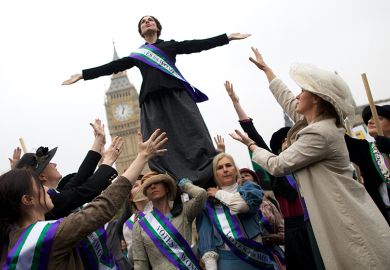You never forget your first vibrator. According to a 2009 study by Indiana University, almost 50 per cent of American women have played with the pulsating devices. That number has undoubtedly climbed thanks to pop-culture phenomena such as Fifty Shades of Grey and marked changes in the “adult industry”. Gone are the days when all sex shops were dives hawking crotchless polyester knickers and sticky men’s magazines, with a dodgy peep show in the back. The sex-toy business has boomed into a purportedly $15 billion (£11.5 billion) a year trade that is increasingly high-end, sophisticated in design and aggressively courting female consumers.
Today’s woman-centric sex gadgets come in all colours and shapes. The packaging is tasteful, the aesthetic is slick and modern, and the marketing taglines boast high-minded goals (“revolutionizing women’s health”) and appeal to neoliberal self-care culture: Gwyneth Paltrow’s lifestyle website Goop touted a $15,000 gold-plated vibrator. Pleasing women is big business.
As The New York Times recently observed in a profile of the Eva vibrator ($109), there is “a recent surge of products that embraces feminism as part of its marketing”. Is this just a ruse to part women from their hard-won 79 cents for every dollar a man earns?
Lynn Comella’s Vibrator Nation: How Feminist Sex-Toy Stores Changed the Business of Pleasure makes the case that our carnal climate was created by a handful of second-wave feminists, sexperts and sex radicals who forged new models of commerce to transform the demographics of access, profit and pleasure. It is a riveting account of the “gravitational shift” in an industry “long dominated by men and viewed by many as antithetical to feminism”. Comella, a professor of gender and sexuality studies at the University of Nevada-Las Vegas, is a lively and authoritative observer-participant who conducted six months of fieldwork at the Manhattan sex boutique Babeland. Blending history, ethnographic and archival research, and interviews with the founding mothers of vibrator nation, Comella tells the story of how feminism and consumer capitalism came together in an awkward embrace that nevertheless changed the sexual culture of America.
Academia’s finest sex-toy monograph to date, Rachel Maines’ The Technology of Orgasm: “Hysteria,” the Vibrator, and Women’s Sexual Satisfaction (1999), set the bar high with its bold analysis of how the vibrator was invented in the Victorian period as a medical device to relieve hysteria. Comella picks up several decades after Maines left off, in a post-war America puzzling through Alfred Kinsey’s Sexual Behavior in the Human Female, Betty Friedan’s The Feminine Mystique and the rise of second-wave feminism in the late 1960s and 1970s. For many women, feminist consciousness-raising meant not just sociopolitical equality but also orgasmic liberation as a form of empowerment.
The Ur-scene of the feminist sex-toy revolution, as Comella tells it, was when a divorced former Second World War Women’s Army Corps entertainer-turned-advertising executive, Del Williams, was embarrassed while trying to buy a vibrator at Macy’s in the 1970s. Williams launched a mail-order business, Eve’s Garden, that by 1979 had blossomed into a store in a midtown Manhattan office building: the first bricks-and-mortar feminist sex shop in America.
The real incubator of the feminist sex-toy uprising, though, was Joani Blank’s Good Vibrations in San Francisco, which Comella describes as “a tiny shop about the size of a parking space, with macramé hangings on the walls and a display case full of antique vibrators”. Through her work as a sex educator and therapist, Blank realised the need for a women-friendly sex retail environment. She founded Good Vibrations in 1977 as a “clean, well-lit” space “especially but not exclusively for women”, offering advice as well as a private room for testing the products – over clothes. In its early days, Good Vibrations was as devoted to creating a community as it was to merchandising. When she began, Blank didn’t have an inkling of a business plan. She just wanted to get the goods out there.
Comella credits Blank with “setting the stage for a sex-positive diaspora that would soon spread to cities across the country”. It was based on a business ethic valuing education, integrity and generosity over the hard sell or the upsell. Blank championed a “communitarian, non-competitive ethos”, practising social entrepreneurship long before it was trendy. When Good Vibrations moved to a larger space, she hired employees as “sex educators” who had virtually no training in retail. Selling was an afterthought.
While sharing the utopian stance of her subjects – “making the world a better place, one orgasm at a time” – Comella doesn’t sugar-coat the story. Eve’s Garden and Good Vibrations “were not nonprofit entities, but in many ways they operated as though they were” – and they had to become more conventional to survive.
Vibrator Nation celebrates the cast of audacious women who led the lusty feminist revolution in San Francisco: Blank (who died in 2016), Susie Bright, Carol Queen and other sex-positive pioneers. A crash course in contemporary gender and sexuality studies, Comella’s book could be a television series every bit as juicy as Sex and the City or Transparent.
Good Vibrations, Episode one: The politics of products! Susie convinces a reluctant Joani to stock porn videos and silicone dildos at the store: Joani explains that she isn’t “anti-dildo but rather pro-clit”.
Episode Two: the Good Vibes gang squabble about lesbian BDSM. Is it anti-feminist? Does it belong in the store?
Episode Three: big changes when Joani makes Good Vibes a worker-owned cooperative. Sounds rad, but what really happens when there’s no one on top?
Episode Four: an irate customer mistakes a butch lesbian employee for a man. The crew raps about gender fluidity and queer and trans identity, and GV hires its first male sex educator.
Episode Five: Joani and Carol infuriate other staffers when they propose a porn series called “The Girls of Good Vibrations”. When is sex work selling out?
Episode Six: The business takes a dive. GV is bought by a Midwestern adult company. What will happen to Joani’s dream?
Tracing the hard lessons of Good Vibrations to other stores it inspired such as Early to Bed, Self Serve, Sugar and Feelmore, Comella focuses on Babeland, drawing on her insider knowledge of its history, politics and philosophy (“Getting a dildo or a vibrator might not change the world, but acting in the interests of your own desire may change you!”). She also looks at the company’s labour practices, including the time when its employees decided to unionise. Like Good Vibrations, Babeland faced a drop in revenue and was forced to confront “the very real struggle between capitalism and the mission”.
After Vibrator Nation went to press, Babeland was sold to Good Vibrations. Far from the scrappy venture it was in 1977, Good Vibrations is now a large corporation, albeit a self-declared “progressive” one. With major chains such as Walmart and Target selling sex toys, will independent stores endure? How will bricks-and-mortar shops compete with e-commerce?
Another twist in sex-positive capitalism is the burgeoning field of sex tech. Innovations in electronic eros, including smart toys, virtual reality porn, teledildonics and digital domains are the new frontiers of sex culture. The commodification of sexuality is as lucrative as ever, and women’s sexuality in particular is considered a ripe market opportunity. But who really benefits when entrepreneurs capitalise on “the orgasm gap”? Very often, sex tech’s marketing ploy is that female sexuality is mysterious, difficult and requires outside intervention. By contrast, the goal of early feminist sex shops was to help women “own” their sexuality, not to create never-ending consumerist desire to assuage anxieties about it. Sex sells, but that’s not always a good thing.
Laura Frost is a writer and cultural critic who was formerly a professor of literature at both Yale University and The New School in New York. She is also the author of Sex Drives: Fantasies of Fascism in Literary Modernism (2001) and The Problem with Pleasure: Modernism and Its Discontents (2015).
Vibrator Nation: How Feminist Sex-Toy Stores Changed the Business of Pleasure
By Lynn Comella
Duke University Press
296pp, £79.00 and £20.99
ISBN 9780822368540 and 68663
Published 8 September 2017
The author

Lynn Comella, associate professor of gender and sexuality studies at the University of Nevada-Las Vegas, was born in Indiana and grew up in Erie, Pennsylvania. She did a first degree in psychology, with minors in women’s studies and anthropology, at Pennsylvania State University, followed by an MA in gender studies and feminist theory at The New School for Social Research in New York City.
“Discovering women’s studies and anthropology as an undergrad student, and learning how to analyse the gendered dimensions of everyday life, was a turning point,” she says. Although she “left The New School with a very solid foundation in social theory”, it wasn’t until she went on to a PhD programme in communication at the University of Massachusetts-Amherst that she “learned how to conduct original research…It was also at UMass where my interests in gender and sexuality coalesced into a research agenda that I’ve been pursuing ever since.”
Her PhD, which eventually became Vibrator Nation , arose out of Comella’s interest in “examining those spaces and places where female sexuality assumed a public presence, as opposed to being relegated to the privacy of the home”. In many ways, she thinks, it is “a very productive and exciting time for serious scholarship on sexuality”, including pornography and “the adult industry”, and such work is “increasingly finding institutional support in the form of research appointments, academic journals and professional organisations”. Yet she acknowledges that “it’s not unusual for researchers who study stigmatised topics and communities to find their research – and sometimes themselves – similarly stigmatised, discredited or marginalised”. She feels “very fortunate to live in Las Vegas, a city known for its highly gendered and sexualised economy. I’m also lucky to work at a university that invites researchers to pursue unconventional research agendas.”
Matthew Reisz
POSTSCRIPT:
Print headline: Happiness lies in your own hands
Register to continue
Why register?
- Registration is free and only takes a moment
- Once registered, you can read 3 articles a month
- Sign up for our newsletter
Subscribe
Or subscribe for unlimited access to:
- Unlimited access to news, views, insights & reviews
- Digital editions
- Digital access to THE’s university and college rankings analysis
Already registered or a current subscriber?




